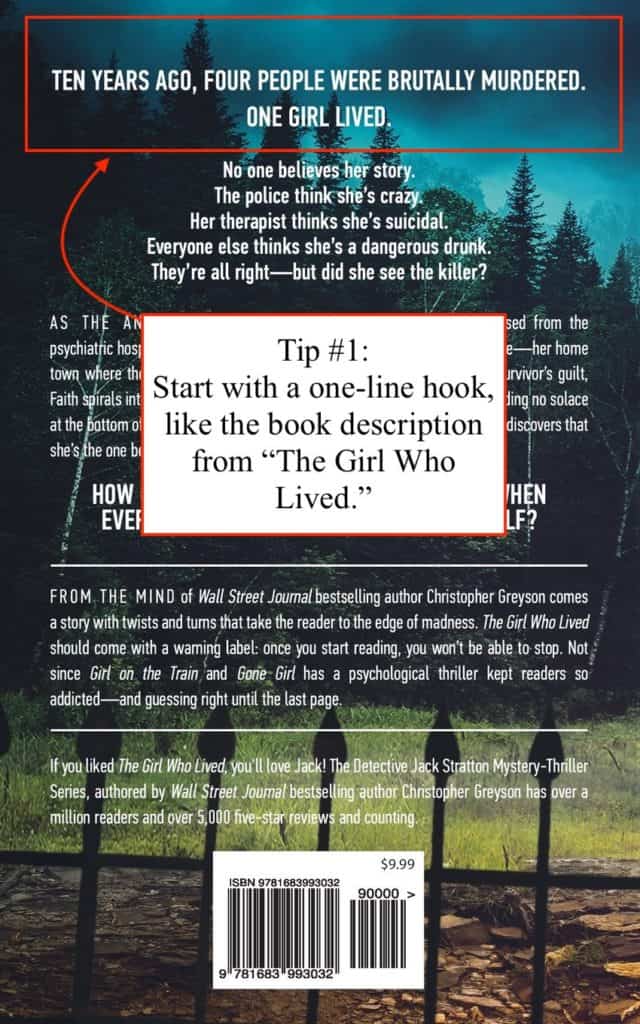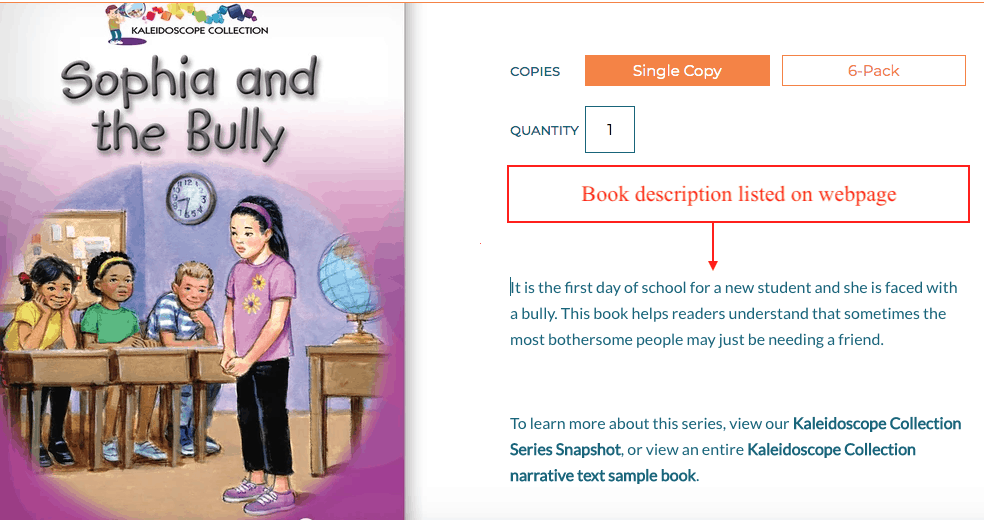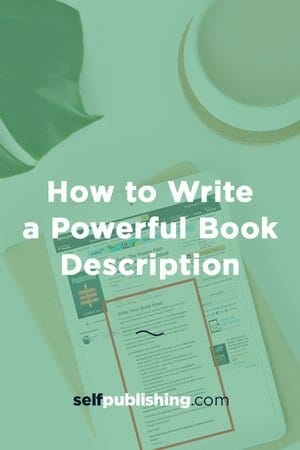Learning how to write a book description that actually gets people interested in buying your book is important for increasing book sales and creating buzz.
Think about it. What makes you pick up or download a new book at the bookstore?
Unless you are a huge fan of the book’s author, you’re first drawn to a catchy title and cover appeal – a provocative illustration or that unique book cover design.
But when you want to know if the book is worth reading (and worth paying good money for), you flip to the back cover or read the description on the website.
There (or just inside the cover), the author has written a “blurb” or description about the book.
The book description includes just enough about what is going to happen in the book, to make the reader yearn for answers to all the questions flitting through his or her mind…if the author has succeeded in writing a captivating description. So how do you write a book description successfully?
For self-published authors, it’s even more important to craft the ultimate book description, so that when people land on your book’s site page, they will be drawn to purchase or download your book. You don’t want all the work you did writing the book to go to waste.
So how do authors do it, you ask? In this article, we’ll show you how to write a book description that sells, captivates, and entices the reader to keep reading.
8 tips for how to write a book description that sells
Whether you’re a fiction or nonfiction author, your book description is the reader’s first introduction to the pages beyond the cover. It’s important to capture interest, spark interest in the topic or theme, and give them just enough information that they can’t help but buy the book for the whole story.
Just follow these tips for how to write a book description, and no one will want to put your book down!
1. Start with a hook sentence
What is the critical issue in your book…the problem that demands to be solved? You need to know the answer before you can learn how to write a book description successfully.
With clever wording, a problem statement might be a great hook to catch potential readers’ attention. Then you can “reel” them in to purchase your book, using the rest of your well-worded blurb.

2. Write in the 3rd person point of view
When you write a book description, you should use the 3rd person point of view. That means using no “I’s” or “you’s”…only “he” or “she.” In fact, it shouldn’t even be written in your “author voice.” When learning how to write a book description, you should pretend to be someone else who is describing your book to potential readers.
3. Word your book description in a way that evokes emotion on-the-spot!
Does the main character greatly fear something? Make the reader feel a bit of that fear. Has the character suffered great loss?
Make the reader sympathize with the character’s distress. We want to understand the emotions the character is going through and what the character motivation is. This can help readers get hooked before they even turn the first page.
4. Tell enough about the plot to make people want to read the book
Introduce the main character and the problem of your story in a compelling way. Offer just enough hints about events in the story to pique reader interest without giving away any of the juicy details.
5. Focus on your book, not on yourself!
When learning how to write a book description, you shouldn’t make it about yourself.
A brief author byline is fine, but readers want to know about the book! If you must mention yourself, remember to continue writing in the 3rd person point of view. Refer to yourself as he or she – you are merely acting as a reporter.
Place the byline last, with a definite space to separate it from the exciting book description.
In most book descriptions, you’ll find a short paragraph about the author only after the actual book teaser has been given.
Here is an example of how to write a book description that includes a concise, informational paragraph about the author.

6. Don’t give away the ending
This might be a no-brainer, but while practicing how to write a book description, you can’t give away the conclusion!
If you share the end of your book on your book cover, why will the reader bother to open the pages?
Give just enough information so that the reader can understand the story’s setting and context, but don’t give away the entire storyline. Leave the reader intrigued enough to want to purchase your book, so that they can discover the ending or any surprise twists on their own.
7. Add a brief testimonial or endorsement
Only use this feature if it enhances your book description.
- The testimonial is a brief blurb by someone who has read the book and has found help or satisfaction by reading your book.
- An endorsement is usually a succinctly-worded paragraph by someone, whose authority the reader will recognize, who reads your book and agrees that you are qualified to write this particular book.
8. Keep practicing!
The best way to learn how to write a book description is to write a bunch of them! Write multiple attempts of your book description. Revise your favorite version as many times as you need to, until you are satisfied with the results.
Of course, sometimes, the only way to learn how to write a book description that actually sells is to get outside input. While you will make the final decision for the book description, it is important to listen to outside suggestions. After all, YOU are not the person buying your book!
Let several colleagues and potential readers (of the appropriate age level) look over your best attempts and offer their input.
BONUS: How to write a book description for nonfiction books
If you are trying to learn how to write a book description for a nonfiction book, it might be slightly different than a fiction book. After all, you aren’t evoking character emotions or teasing about a plot!
Use these questions to help you learn how to write a book description for nonfiction works:
- Do you offer a unique point of view on a particular topic?
- Do you have years of experience in research or practice?
- Does your “author’s voice” appeal to the reader in a special way?
- Do you bring new knowledge to the reader which other writers have not done?
- Are the illustrations or photographs of exceptional quality and rarity?
How to write a book description, when the book is not yours…
If you’re writing a book description for someone else’s back cover, be sure to follow the suggestions above.
Several years ago, I was privileged to be a ghostwriter for a unique book of memoirs. You can read the book description I provided at Harbor Knight: From Harbor ‘Hoodlum’ to Honored CIA Agent.
When writing the back cover description for a book of memoirs that stretches over a lifetime, it can be challenging to pinpoint that single, most important thread that describes the path this person has trodden through life.
But that is precisely what you need to share with the reader. What made this person unique?
If this is a book of memoirs, you need to know the person’s story fairly well in order to learn how to write a book description about them. Do a brief interview to understand the person’s background. Make sure that you read the whole book manuscript. This will help you find common themes and personality traits that run from one decade into the next.
Use the person’s own words, when possible, so that his or her voice is heard. Be respectful with this task you’ve been asked to perform.
If (for some reason) you find the manuscript distasteful and feel that you are not able to offer a captivating description for the back cover, do the right thing. Turn down the request to write this particular book description.
Now that you have plenty of tips for how to write a book description, I’d like to show you a few examples of my own book descriptions so you can learn from them and from their writing process.
A few examples of how to write a book description
Here is an example of a back cover description from my first children’s chapter book.
Swimming brings back a nightmare that Rebecca Fishburn would much rather forget.
So when the gym teacher announces plans to take the class swimming for the next two weeks, Reb can think of nothing else…and she is terrified!
She must do whatever it takes to stay out of the water.
Reb is convinced that she must lie…or she just might drown!
Reb Fishburn: In Too Deep
I played around with the description for several weeks, before settling on the blurb (see above) for my back cover. I wanted to write “Reb is convinced that she must lie or she just might die.” I wanted to help the reader experience the enormity of Reb’s fear.
But after sharing this rough draft with other elementary school teachers and parents, they felt that the sentence wording was too horrific for the young reader.
I took their advice and changed that single word. After all, the potential buyers of my book include teachers and parents. If they found the sentence offensive, so might many others.
For another children’s book I wrote, I used a simile to tease the reader’s curiosity:
You might not expect to discover gold on a country farm, but Grandpa knows just where to find this hidden treasure.
Dig into Grandpa’s Hidden Gold Farm for a sweet and yummy treat!
Grandpa’s Hidden Gold Farm
The cover illustrations and the title offer clues about the kind of hidden treasure tucked inside the book, but the description never mentions bees or honey!
Sophia and the Bully is a children’s book I wrote for Hameray Publishing’s Kaleidoscope series. The company chose the following description to sell this book (202 words) on their website:
It is the first day of school for a new student and she is faced with a bully. This book helps readers understand that sometimes the most bothersome people may just be needing a friend.
Sophia and the Bully

The person writing this description chose to offer the reader a brief main idea paragraph, without revealing any of the events from the story. The book, written for beginning readers, contains only 12 pages. In that case, describing any single event would be to give away the whole story!
When deciding how to write a book description, you must think of who your audience will be, and make your book description appeal to those individuals.
A teacher, for example, is drawn in by the simple description of this little book for several reasons:
- Throughout the school year in most teachers’ classrooms, new students come and go.
- Just because a child can do annoying things to other students, that does not mean the child is a bully.
- Students need to know the difference between a bully and a potential friend.
- Bullying is a theme the school wants addressed in the classroom.
- Reading a book aloud to the class or having a small group of beginning readers read the book together offers the teacher a non-threatening way to discuss bullying.
Obviously, the genre of your book will affect how to write a book description greatly.
Here is how to write a book description for other genres:
- A cookbook may entice readers with delicious words and samplings from the specific type of recipes written between the covers.
- A thriller might show the comparison between this book and a similar tale by a better-known author–with just enough details to send chills up the reader’s spine.
- A romance will certainly tug on the reader’s heartstrings, divulging the names of the main characters and suggesting a problem that could keep the two from coming together!
- A nonfiction book will provide an overview of what new and exciting concepts or facts the reader is going to learn. If any special chapters, illustrations or photos are included in the book, these should be mentioned in the book description.
- A self-help book will describe the book’s layout and explain why the author is qualified to write a new book on this particular topic. A few details or a real-life example from the chapters within will show the reader that he or she may have finally found the answer to his or her problem.
- A historical fiction book will place the fictional main character within an accurately depicted time and place, when an event of great magnitude (from actual history) is about to happen – and a captivating book description will include all of these details.

…and the list goes on.
The best way to know how much detail to include in your description is by traveling to the local library or bookstore and holding real books in your hand.
There, you’ll have thousands of books at your fingertips. You will quickly realize how one author works his or her magic, causing you to want to read more, and why another author’s book cover fails to pique your interest.
Become familiar with how other writers within your genre handle the back cover book description. See for yourself how the title, cover illustrations, and book description work together to make the reader want to know what lies within the pages.
Spread your book description far and wide!
The primary reason you have just spent so much time and energy writing this winning book description is to sell your book!
Write it. Rewrite it. Play with adjectives, phrases, and different literary techniques. Move sentences around to make it flow more easily.
Remember, if you must put your byline on the back cover, do so at the very end.
Set it apart from the book description…unless, of course, you’ve already written a popular book or you are famous in some other way. Then your name is almost as important as your book’s content.
Be clever. And give this book cover the most captivating description that you have ever read!
If your book description is clever enough, the “blurb” that you have just written can be used to promote your book in many places.
Here’s where to include your book description:
- Newspaper press release (this is free advertisement, in most newspapers)
- Your book launch event (this may be free if you agree to be interviewed)
- Catalog item description for companies who will sell your book
- Letter to potential storefronts wanting to sell your book
- Brochure for groups wanting to use your book for book talk
- Amazon listing
- Blog post
- Your author website
- Social media posts–personal and professional sites
Now you know exactly how to write a book description and what to do with it when you are done – so get your words out there and wow the world.
